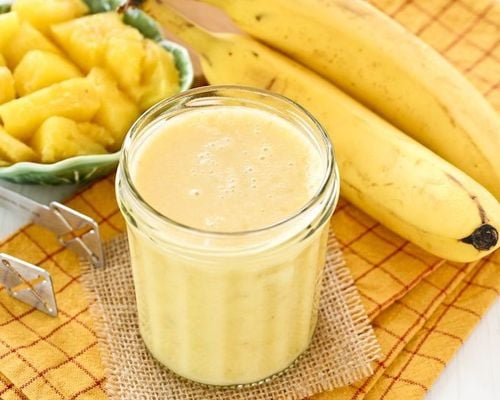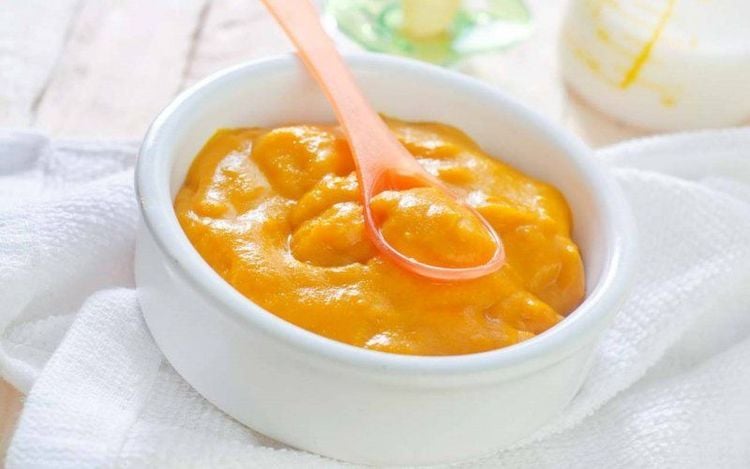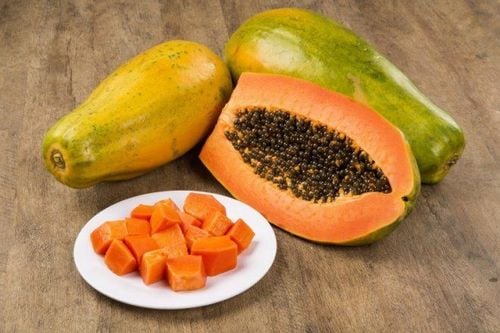This is an automatically translated article.
When babies begin to transition to solid foods, parents need to learn to know exactly what foods to choose for their baby's meals. By cooking their own meals at home, parents can keep track of their baby's daily menu composition. At the same time help children confidently enter a new stage of development.1. Why cook your own food?
Although convenient, commercial baby food can lose vitamins and nutrients during processing, as well as cause children to feel "sick".The American Academy of Pediatrics recommends waiting up to 6 months to start introducing solids, but some people can start as early as 4 months if certain developmental stages have been reached.
According to some studies, infants who start eating certain solid foods at the age of 6 months have a reduced risk of allergies and asthma. And your baby begins to be interested in solid foods.
Some things to keep in mind when cooking for your baby:
New babies only need about 1 to 2 spoons of a type of food, so divide the portion into small portions. Be on the lookout for food allergies in your baby, especially when feeding your baby foods that contain common allergens. Common allergens are found in foods, including: Eggs, peanuts, wheat, soy, fish and shellfish. Certain foods may have higher pesticide residues, including: Apples, peaches, nectarines, strawberries, grapes, celery, spinach, bell peppers, Cucumbers, cherry tomatoes, beans Dutch, potatoes... When feeding children, parents need to pay attention.
2. Recipes for babies from 4 to 6 months old
When babies are 4 to 6 months old, parents will want to use simple, 1-ingredient flours. Baby recipes can help detect and determine if your child has allergies or food sensitivities. When children are familiar with foods, you can try combinations to increase taste and ease of eating.Some recipes for kids include:
2.1 Chickpeas meal Peas provide plenty of vitamins A and C, iron, protein and calcium. If the pods of the peas make your child's texture less appealing, be sure to squeeze them to make it as smooth as possible.
2.2. Banana puree

huối cũng được biết đến như 1 trong những thực phẩm bao gồm loại thuốc kháng axit tự nhiên và rất nhẹ nhàng đối với dạ dày
2.3 Baby Brown Rice Cereal Rice cereal is among the most popular foods introduced because it is hypoallergenic and easy to digest. Mixing brown rice with a fairly thin texture can help babies transition from an all-liquid diet to a more solid one. This procedure can be applied to oats.
2.4 Mashed Avocado This avocado is a great “good fat” food for your baby's brain and physical development. In addition, when avocado is mashed, this dish is quite attractive to children because of its smooth texture and ease of use. To help prevent butter from browning, store your pureed avocados in the refrigerator.
2.5 Baked sweet potatoes Adults know to eat sweet potatoes because of the health benefits that this food brings. What's more, sweet potatoes are packed with vitamins, antioxidants, and fiber, so your baby can benefit from this delicious root, too.
A simple mash with water or milk makes a delicious and nutritious first dish.
2.6 Carrot Mashed Carrots have a natural sweetness and texture that is easy to use. This simple carrot recipe provides an abundance of the antioxidants beta carotene and vitamin A.

3. Recipes for babies from 7 to 9 months old
For babies between 7 and 9 months old, you can cook thicker dishes with more ingredients. You can also add foods rich in nutritional value such as: Meat and other proteins at this stage, or even earlier if your pediatrician allows.3.1 Pumpkin Thyme Soup This dish is quite rich in beta carotene, potassium and iron.
3.2 Spinach with white sweet potato The spinach and sweet potato combination helps add a healthy dose of calcium, iron, vitamin A and folate to your baby's diet. Alternatively, yam can be used to add a bit of sweetness to make a pleasant introduction for your baby.
3.3 Beets and blueberries mashed This dish not only has a beautiful bright red color but is also a nutritious combination of antioxidants, vitamins and fiber. You can also mix this with a little cereal for a delicious breakfast for your baby.
3.4 Avocado and Banana for Baby Weaning is a wonderful combination of two foods: Avocados include good fats and fiber, and bananas include: Potassium and vitamin C. Bananas also add sweetness and soften the buttery taste.
3.5 Ground Vegetables Potatoes, carrots, peas and fish make for a delicious combination that can be eaten in less than 8 minutes.
3.6 Pumpkin and pear puree Pumpkin, great ingredient because it rarely causes allergies. Pears add sweetness to this dish.
3.7 Ripe Papaya Papaya is more acidic than many other fruits, so you should give it to your baby when he is 7 or 8 months old. The enzymes in papaya (and in pineapple) aid in digestion, so it could be a perfect food to help relieve your baby's constipation or indigestion.

Đu đủ có tính axit cao hơn nhiều loại trái cây khác, vì vậy bạn nên cho bé sử dụng khi bé được 7 hoặc 8 tháng tuổi
4. Recipes for babies from 9 to 12 months old
By the age of 9 to 12 months, babies can enjoy mashed and pureed foods more. You can also add milk or dairy products, such as cheese or yogurt, to their food. At this stage, many babies can even transition to adult foods and complex combinations, purees or soft cooks.4.1 White fish, carrots and leeks This combination makes for a delicious and brain-boosting dish. White fish is a good source of omega-3 fatty acids and may help promote the development of your baby's central nervous system. Leeks are said by some to support the heart, and carrots are packed with antioxidants.
4.2 Quinoa Soup The ingredients of a traditional soup meet the super grain - quinoa - in a delightfully "gourmet" taste.
4.3 Beef Stew With Infants This classic safe food is packed with iron, thanks to the beef. Beef recipes require a little more preparation time than other recipes.
4.4 Blueberries, Mangoes, Avocados and Chili This recipe combines creamy butter, tangy mango, blueberries and the delightful addition of green peppers for a nutritious side dish.
4.5 Provencal Creamy Chicken Dishes as a mild blend of spices can help introduce children to more appealing flavors without the added salt.
4.6 Banana quinoa puree Quinoa is a high-protein cereal that makes a great addition to a growing baby's diet, making a fun new addition to mashed bananas, an ingredient that babies love. may have liked.
Alternatively, you can also try feeding your baby cooked quinoa. The cooked nuts stick to your baby's fingers, making it an easy treat.
4.7 Mint and Cherry Greek Yogurt This homemade cherry tart is a delicious topping for a yogurt base.
4.8 Apricots and Bananas with Cinnamon Add a dash of cinnamon to dishes for a great breakfast, you can try adding this mixture to a little cereal or cooked oatmeal.
For children to be healthy and develop well, it is necessary to have a nutritious diet in terms of quantity and quality balance. If children are not provided with adequate and balanced nutrients, it will lead to diseases of excess or lack of nutrients, which adversely affect the comprehensive development of children in terms of physical, mental and motor skills.
Children who do not eat properly are at risk of micro-mineral deficiency causing anorexia, growth retardation, malabsorption,... If they notice the above signs, parents should supplement their children with products. The supplement contains lysine, essential micro-minerals and vitamins such as zinc, chromium, selenium, and B vitamins to help fully meet the nutritional needs of children. At the same time, these essential vitamins also support digestion, enhance nutrient absorption, help improve anorexia, and help children eat well.
Parents can learn more:
Signs of zinc deficiency in children
Micronutrient deficiency and failure to gain weight in children
Please regularly visit Vinmec.com website and update useful information to take care of your child. Take care of the baby and the whole family.
Reference source: healthline.com













